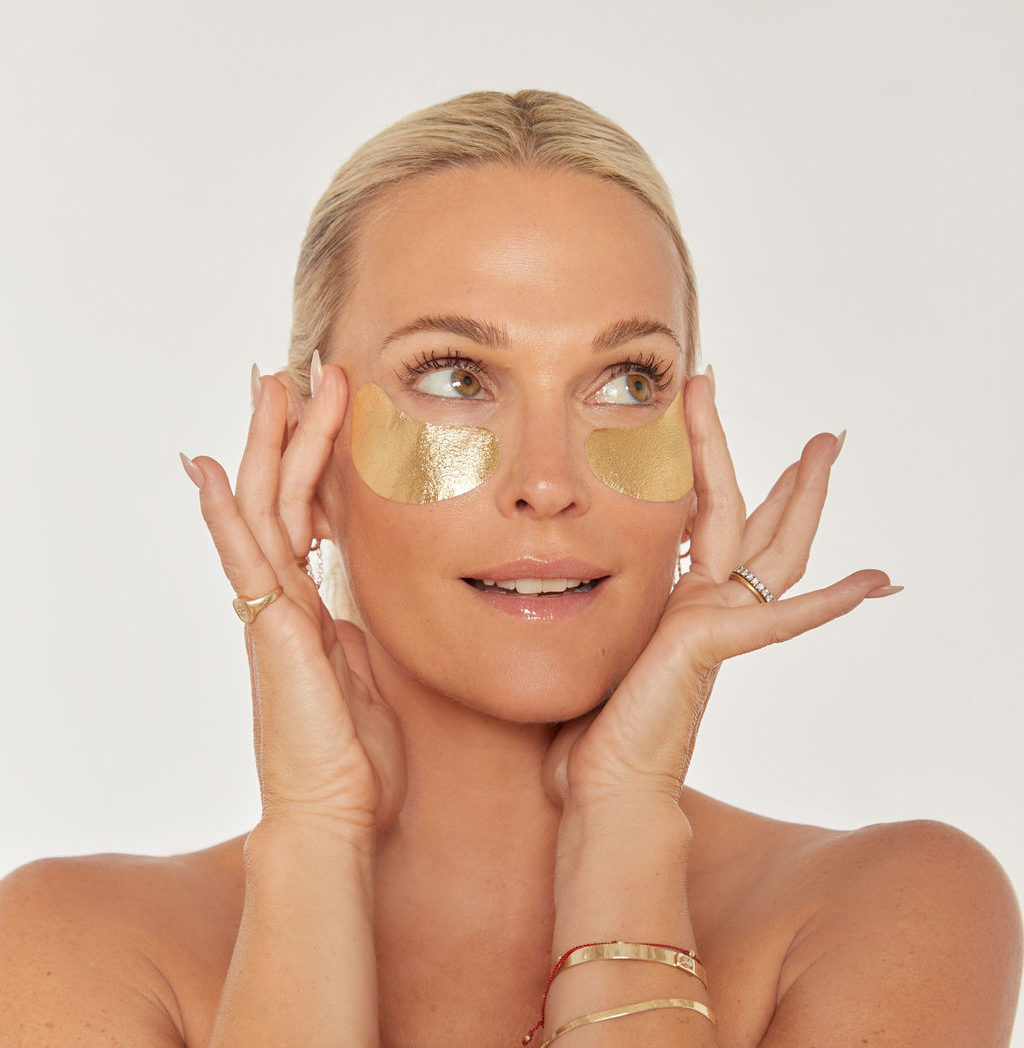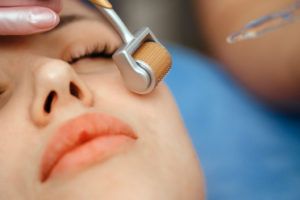Beauty...

Suppose filler under the eyes isn’t your thing, and you’re not about to pony up (and lie down) for a more invasive procedure like an ablative laser or even an eyelift to get rid of bags and under-eye wrinkles. Can something as simple as using an at-home microneedling roller (also known as a dermaroller) do the trick? Believe it or not, you may be able to roll your way to younger and fresher-looking eyes that don’t boast the signs of sleepless nights, exhausting days, and the aging process itself.
Fine lines and wrinkles are an unfortunate but inevitable rite of passage in the realm of aging. With age, collagen, elastin, and moisture levels deplete, leaving the skin less bouncy and tight than in our younger years. Additional factors, like hormonal changes, sun exposure, and smoking, further contribute to the breakdown of the quality of the skin, which can accelerate aging and accentuate facial wrinkling.
“Repeated facial movements, like squinting or smiling, cause the formation of etch marks around the eyes that contribute to the appearance of aging skin, too,” says Dr. Brendan Camp, a board-certified dermatologist in New York City. “Also, a loss of fat under the eyes can make the lower eye look sunken, which gives a tired look.”
You’ve probably heard at least a dozen times that microneedling treatments of all types create tiny yet controlled micro-injuries in the skin that, as they heal, prompt new collagen to form. But what does the term collagen stimulation mean to the layperson? And why is it essential for healthy skin?
Collagen is the cornerstone of healthy, plump, youthful, cushiony skin, but we naturally lose collagen as we age. Without this essential skin protein, the skin can sag and lose its firm, taut appearance. Treatments, like microneedling, prompt the skin to make new collagen and lead to firmer, plumper skin.
“Microneedling stimulates collagen and thickens the skin to help thicken the skin and reduce puffiness,” says Kerry Benjamin, aesthetician and founder of StackedSkincare.
A good alternative to more invasive anti-aging eye treatments like injectables and fillers, microneedling improves the tone and texture of the skin both immediately and over the long term. “By creating micro-injuries to stimulate collagen production, your body improves the appearance of fine lines and wrinkles in the treated area for a short time,” says Dr. Sarah Allen of The Skin Clique.

@adobestockimages
Both dermal rollers and professional microneedling treatments lead to the same result: thicker, firmer, more youthful skin with less visible pores and improved tone and texture that boasts a decent amount of collagen. And the way each one accomplishes this is by creating safe and controlled micro-injuries in the skin that produce new collagen. “These multiple, small, superficial injuries in the skin stimulate the skin to repair itself by making new collagen,” says Dr. Camp.
“Microneedling works well for addressing under-eye concerns and can stimulate new collagen to help firm the skin and lessen the appearance of crepey skin,” he adds.
Perhaps the most significant difference between at-home rollers and what is performed in-office by a professional is the depth and penetration of the needles. At-home tools work more superficially, whereas in-office procedures can go deeper into the skin for better response, albeit with some minor downtime. As Dr. Allen explains, in-office microneedling treatments are intended for single-use of the microneedles, which are longer and penetrate deeper within the top layer of skin. “Home rollers are designed to be used multiple times, which can compromise the result and safety of the procedure.” There’s no right or wrong approach since time, budget, commitment, and personal preference factor into the right modality for you.
At-home dermarolling is effective and way less painful than the professional version. Still, it’s important to remember that shorter and smaller needles housed within rollers add a safety precaution for at-home users. Benjamin says while you can safely use a .2mm roller (anything too large can damage the skin) and get great results, the real purpose behind a smaller dermaroller is to drive the active ingredients in serums deeper into the skin while stimulating collagen.
“If you are buying serums, buy a roller, and vice versa since they go hand in hand and make each other work optimally,” she adds.
At-home devices and tools require commitment and consistency to see results (anything that is an at-home option will always be less intense than professional versions, so the results will not be as dramatic or as fast). “They may also need to be used over a longer period, anywhere from three to six months, to see visible results,” says Dr. Camp.
Professional-grade microneedling requires topical numbing cream before the treatment (without it, it’s pretty intolerable), which delivers the needles at a deeper depth (about 1mm and deeper) than what you can do at home. “These needles go much deeper and will stimulate greater collagen production,” Benjamin says. But, of course, the professionally-administered option is more expensive than the DIY version and can even be used in tandem with Platelet-Rich Plasma (PRP). “This uses blood in a centrifuge machine to pull out PRP, which contains growth factors, which is then applied to the skin,” Benjamin says. “Growth factors stimulate collagen and speed cell turnover and healing, making this super powerful because you are stimulating collagen both physically with microneedling and topically with growth factors.”
Keep in mind that most providers recommend a series of treatments to reap the full benefits.
As Benjamin explains, pairing dermarolling with serums rich in active ingredients will help smooth fine lines, conceal dark spots, and even help with undereye puffiness.
“Microneedling will help reduce puffiness by increasing collagen to the area and adding volume where volume is lost,” she says.
The same goes under-eye darkness. “The skin is very thin in that area, and microneedling helps thicken the epidermis, concealing the dark circles,” Benjamin says. Darkness under the eyes is usually a sign of pooling blood, and because the skin is thin, the area appears dark. “But by thickening the epidermis, you can conceal the dark circles.”
For a one-two punch, Benjamin says to pair at-home microneedling with a good lightweight eye cream, like StackedSkincare’s Firming Eye Complex, which is loaded with the brand’s proprietary Adaptive Complex 25™. “It is a combination of several peptides and other active ingredients that soften the look of lines and diminish dark circles’ appearance. It also contains astaxanthin, a powerful antioxidant that will protect against UV and blue light and absorbs quickly into the skin,” she adds.
She also recommends using an Ice Roller after microneedling to help further reduce dark circles and puffiness under the eyes.
In addition to stimulating collagen for healthier, firmer skin, the micro-injuries that microneedling creates also allow for better absorption and penetration of skincare ingredients applied to the skin afterward. While some ingredients (mainly vitamin C and retinol) should not be used directly on just-rolled or-needled skin because of their potential to irritate the skin, others, like peptides, stem cells, and hyaluronic acid, are perfectly acceptable and encouraged to use.
Dr. Camp says dermarollers specifically pair well with ingredients that will facilitate the healing process, encourage collagen production, and hydrate the skin, like peptides, stem cells, and hyaluronic acid. “You can apply serums with these ingredients before and after a dermarolling treatment,” he adds.
The actives in your favorite face and eye creams and serums work that much harder since they are delivered deeper into the skin. “If you increase the penetration of these agents and allow them to work deeper within the most superficial layers of the skin, the appearance of pigment (melasma included) would improve,” says Dr. Allen.
“Microneedling could affect the appearance of undereye puffiness transiently as the skin under the eyes heals and becomes firmer.” However, she does point out that most of the studies conducted for under-eye darkness combined microneedling and lightening agents or chemical peels.
Although dermarolling and microneedling at home can help improve the look of aging eyes, it’s essential to know that there are potential downsides to the treatment if rolling is not done right.
To effectively roll your way to younger-looking eyes, you can roll as little as a few times a month to as often as daily as long as you use a tool or device with short needles. “For longer needles, once every four weeks is recommended,” says Dr. Allen. “Overdoing it can do more harm than good, including darkening (over-use injury hyperpigmentation) or scarring,” she adds.
To start, wash the skin and make sure it’s clean and completely free of makeup and sunscreen. Next, apply a lightweight serum or oil and begin gently rolling the skin in any pattern with gentle pressure.
After rolling, you’ll want to apply an eye cream or serum with hyaluronic acid or growth factors, like Neocutis Bioserum Firm, Neocutis Lumiere, or ZO Growth Factor Serum. Finally, clean your dermaroller well.